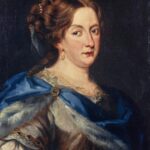
Daughter of Gustav II and Maria Eleonora of Brandenburg, she inherited the throne at the age of six after her father’s death in 1632. She was educated as a male heir to the throne and was taught religion, philosophy, Greek and Latin by the theologian Johannes Mattiae, who considered her to be of brilliant intelligence. Christina, after her coronation in 1650, attracted to her court a number of scientists, musicians and literati, among them Descartes, due to the queen’s request to create an academy of the arts in Sweden. His real interest was in study, which occupied him long hours a day, sleeping only three or four hours. In 1653 he ordered a list of 6,000 books and manuscripts to be made and sent to Antwerp together with valuable paintings, sculptures and tapestries, where he moved in 1654, previously designating Charles Gustav as the new Swedish successor. In December 1655 he arrived in Italy where he converted to Catholicism and the day after his arrival he met Bernini, with whom he maintained a lifelong friendship. Although he settled in the Vatican wing, he took up residence in the Palazzo Farnese so that he could talk and discuss with the poets and intellectuals who came there. In 1660 he returned to Sweden after the death of his nephew Charles and finally returned to Rome, where he settled permanently.
Collection: Images
Project: 5. Power and powers in the history of Europe: oligarchies, political participation and democracy., 8. Women and the change for gender equality in Europe.
Chronology: XVII
Scope: Secondary education, Baccalaureate, University
Link: https://www.investigart.com/2016/11/22/cristina-de-suecia-una-minerva-irreductible/
Resource type: Image
Format: Oil on canvas (67,3 x 54,6 cm)
Source: National Galleries Scotland (Edimburgo)
Language: Spanish
Date: 1670-75
Owner: Álvaro Romero González (Modernalia)
Identifier: NG2708
Copyright: National Galleries Scotland (Edimburgo)
Abstract: Christina of Sweden, the Athena of Europe in the 17th century
Image
Tags






